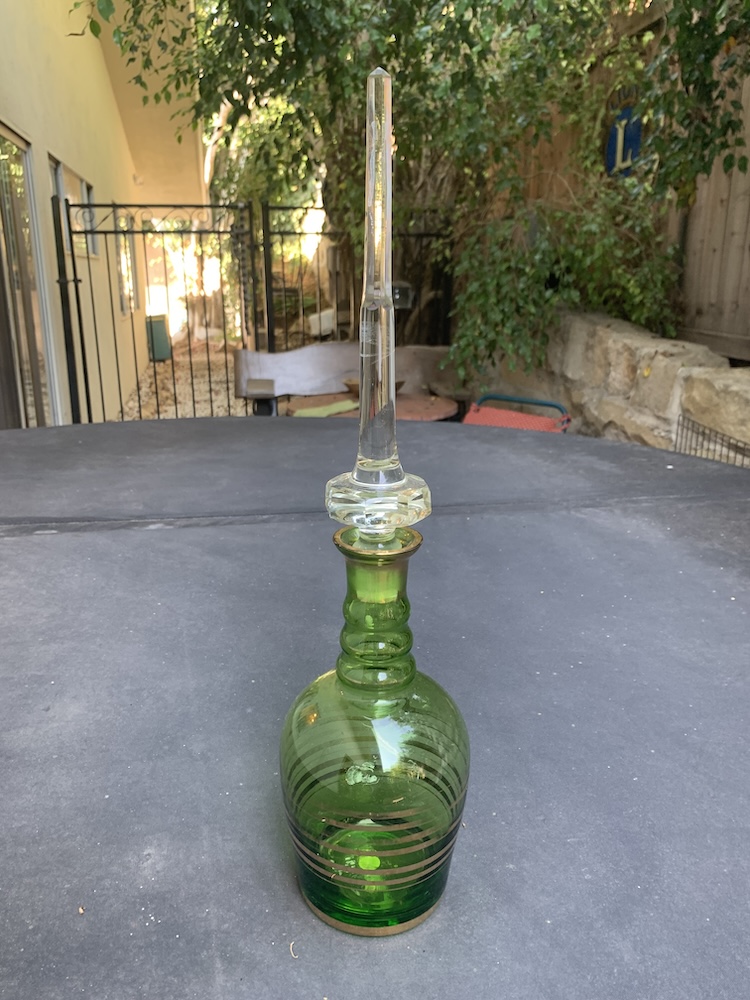Art Deco Decanter

JE has an elegant Art Deco green glass decanter trimmed with gold leaf and topped by an 11-inch clear glass stopper. It is likely of Italian or Czechoslovakian origin, because in the 1930s to 1940s Art Deco glass with gold was a signature of these two glass making centers.
The shape is not the kind we associate with wine decanters used for fine reds, but instead this shape held spirits – likely clear spirits such as gin or vodka – and was probably part of a bar set that included matching glassware. Sets like these exploded onto the American scene after Prohibition ended in 1933. Happy to be drinking again, Americans enjoyed fancy barware, and home bars appointed in custom bespoke fine furniture cabinets. Seeing a decanter like this makes me think of Cole Porter’s “I Get a Kick Out of You,” first performed on Broadway in the show Anything Goes a year after the end of Prohibition: “I get no kick from champagne/Mere alcohol doesn’t thrill me at all/So tell me why should it be true? /That I get a Kick out of you……..”
The decanter has a history that stretches back to Greece and Rome, when your servant could not lift the heavy clay wine amphora to the reclining dining couches, so (in the best households) a smaller vessel made of glass was used. Of course, the shape mattered because the wine needed to breathe and aerate. The difference between a decanter and a carafe is that a decanter has a stopper, which is useful during a long Classical Roman dinner party to keep the wine fresh. The distinction is made today of the two types of wine vessels.
As wine grew in popularity in England in the 17th century, it was shipped from Italy or France, and because of the travel rigors, stirred up wine needed to be cleared of sediments before serving. A British inventor who loved Venice, George Ravenscroft, brought a glass making formula over from Murano in 1676 to make crystalline glass (leaded glass) that was clear, so the wine’s sediments and residues could be seen when decanted. That sediment was bitter to the taste. The Venetians also rediscovered the shape of the glass decanter in the 15th century period, the Italian Renaissance, in which the wide-bodied bowl exposed the wine to air and the long neck kept scents inside. The Venetians invented types of necks for types of wines: the Standard neck, and the Cornett, Duck, and Swan necks. Ravenscroft also “borrowed” this shape and brought his “invention” to London where it changed the marketing of wine.
Previously, wine “lived” in dark glass bottles. Suddenly wine that had been cloudy could be sold. Decanters today are still used as both a symbol and, for some heavier bodied reds, as a preference. The shape has remained the same since the 17th century: a narrow neck and a wide bodied bowl. The narrow neck of the decanter keeps the aromas in the wine, but lets the tannins dissipate when exposed to oxygen across the expanse of the bowl.
Experts say that the use of a decanter has much the same result as that ostentatious but functional “swirl” of wine in a properly shaped wine glass, where a wine snob might swirl a glass to stimulate the oxidation process, and to trigger the release of aromatic compounds in the wine.
JE’s decanter probably did not hold colored spirits because the green glass was prized and displayed as pure green because it contained traces of uranium, popular until World War II when it became critical for the war effort. If the following spirits were poured into green glass, the glory of the green color would not shine through. But all these spirits were decanted in the mid-20th century for your 1930s classy home bar: rum, cognac, bourbon, whiskey, tequila, rye, brandy, and Armagnac.
Spirits can be stored in a stoppered decanter for up to two years, as opposed to wine which should be served after two hours from a decanter. In fact, light bodied reds such as zinfandels only need 20-30 minutes exposure to oxygen. It is the full-bodied wines like cabernet sauvignon which may require an hour or two in a decanter – but wine experts differ on this. JE’s decanter, because of that fabulous stopper, is worth $300. But I bet you can picture it on an Art Deco-style booze cabinet as it helped pour out that long awaited post-Prohibition gin.







You must be logged in to post a comment.